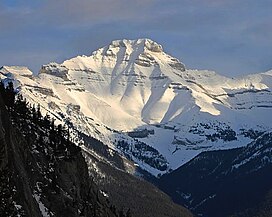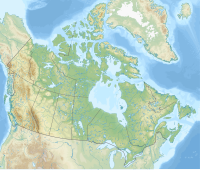geo.wikisort.org - Mountains
Mount Inglismaldie is the second highest peak of the Fairholme Range in Banff National Park. It is located immediately west of Mount Girouard in the Bow River valley south of Lake Minnewanka.
| Mount Inglismaldie | |
|---|---|
 Mount Inglismaldie in winter | |
| Highest point | |
| Elevation | 2,964 m (9,724 ft)[1] |
| Prominence | 160 m (520 ft)[2] |
| Coordinates | 51°14′30″N 115°25′15″W[1] |
| Geography | |
 Mount Inglismaldie Location in Alberta  Mount Inglismaldie Mount Inglismaldie (Canada) | |
| Location | Alberta, Canada |
| Parent range | Fairholme Range Canadian Rockies |
| Topo map | NTS 82O3 Canmore |
| Geology | |
| Age of rock | Cambrian |
| Type of rock | sedimentary rock |
| Climbing | |
| First ascent | 1933[1] |
| Easiest route | Scramble |

The mountain was named in 1886 by park superintendent George A. Stewart after Inglismaldie Castle in Kincardineshire, Scotland.[1]
The first ascent of the mountain was made in 1933 by H. Foster, J. Packer, M.C. Wylie, Betts, Dickson, W. Innes, L. DeCouteur, J. Miskow, Sadler, and Vallance with guide Lawrence Grassi.[1]
Geology
Like other mountains in Banff National Park, Mount Inglismaldie is composed of sedimentary rock laid down during the Precambrian to Jurassic periods.[3] Formed in shallow seas, this sedimentary rock was pushed east and over the top of younger rock during the Laramide orogeny.[4]
Climate
Based on the Köppen climate classification, Mount Inglismaldie is located in a subarctic climate with cold, snowy winters, and mild summers.[5] Temperatures can drop below −20 C with wind chill factors below −30 C. Precipitation runoff from Mount Inglismaldie drains into Lake Minnewanka and the Bow River.
References
- "Mount Inglismaldie". PeakFinder.com. Retrieved 2019-09-13.
- "Mount Inglismaldie". Bivouac.com. Retrieved 2006-09-27.
- Belyea, Helen R. (1960). The Story of the Mountains in Banff National Park (PDF). parkscanadahistory.com (Report). Ottawa: Geological Survey of Canada. Archived (PDF) from the original on 2015-10-02. Retrieved 2019-09-13.
- Gadd, Ben (2008). "Geology of the Rocky Mountains and Columbias" (PDF). Archived from the original (PDF) on 2012-04-02. Retrieved 2010-01-01.
- Peel, M. C.; Finlayson, B. L. & McMahon, T. A. (2007). "Updated world map of the Köppen−Geiger climate classification". Hydrol. Earth Syst. Sci. 11: 1633–1644. ISSN 1027-5606.
External links
- National Park Service web site: Banff National Park
- Mount Inglismaldie weather: Mountain Forecast

Другой контент может иметь иную лицензию. Перед использованием материалов сайта WikiSort.org внимательно изучите правила лицензирования конкретных элементов наполнения сайта.
WikiSort.org - проект по пересортировке и дополнению контента Википедии